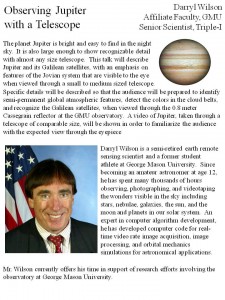George Mason Observatory’s ‘Evenings Under the Stars’ series (where you’ll also get to look at awesome galaxies, stars, planets and more through our 0.8 meter telescope!) is back for Spring 2014! The next event will be Monday, February 24th and will feature a talk by Darryl Wilson on ‘Observing Jupiter with a Telescope’! Talk at 6:00 PM. Observing starts at 6:30PM until 8:30PM. Arrive at the lobby of Research Hall. As always the event is free and everyone is invited! We hope you can come out and join us!
Remember that there will only be one talk given during each observing session so make sure you don’t miss it! Directions to GMU and Research Hall here: http://eagle.gmu.edu/map/fairfax.php Zoom in to find Research Hall next to engineering building and York River Rd. Keep an eye on twitter for updates – Just keep an eye out for weather – the event may be postponed or cancelled due to bad conditions – updates will be available here – Observatory Twitter
About the talk:
The moon is in the night sky. It is also large enough to show recognizable detail with almost any size telescope. This talk will describe Jupiter and its Galilean satellites, with an emphasis on features of the Jovian system that are visible to the eye when viewed through a small to medium sized telescope.
Specific details will be described so that the audience will be prepared to identify semi-permanent global atmospheric features, detect the colors in the cloud belts, and recognize the Galilean satellites, when viewed through the 0.8 meter Cassegrain reflector at the GMU observatory. A video of Jupiter, taken through a telescope of comparable size, will be shown in order to familiarize the audience with the expected view through the eyepiece
About the speaker:
Darryl Wilson is a semi-retired earth remote sensing scientist and a former student athlete at George Mason University. Since becoming an amateur astronomer at age 12, he has spent many thousands of hours observing, photographing, and videotaping the wonders visible in the sky including stars, nebulae, galaxies, the sun, and the moon and planets in our solar system. An expert in computer algorithm development, he has developed computer code for real-time video rate image acquisition, image processing, and orbital mechanics simulations for astronomical applications. Mr. Wilson currently offers his time in support of research efforts involving the observatory at George Mason University.



 Additional questions and feedback on the Observatory site can be addressed to:
Additional questions and feedback on the Observatory site can be addressed to: